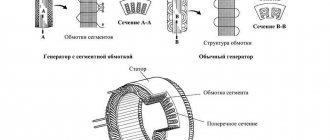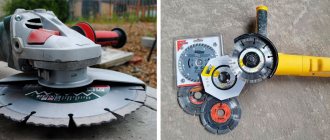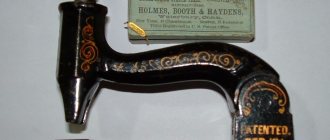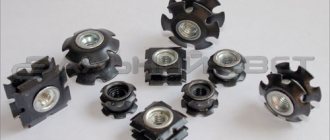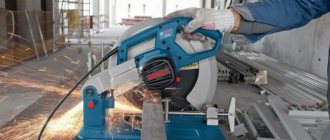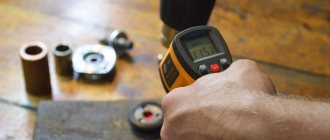The term “grinder” refers to an angle grinder (angle grinder), which appeared on the market in the mid-70s of the last century. The birthplace of the instrument is Bulgaria, which served as the prototype for the affectionate nickname that has taken root in everyday life.
Currently, this grinder is an integral part of the working tool of any home craftsman. Given the demand, the market offers various models of equipment intended for domestic and professional use.
Choosing an angle grinder is not difficult; the main thing is to determine exactly for what purposes the tool will be used and know the characteristics that are worth paying attention to.
General information
The intended purpose of the tool is revealed in its name. This is an angle grinder, therefore, grinders were originally created for grinding hard surfaces. However, many craftsmen use a power tool as a saw, cutting off metal pipes, fittings and other durable materials that an ordinary hand saw cannot handle.
This versatility is explained by the fact that the market flexibly adapts to the consumer, offering various types of discs and attachments designed to work with metal, concrete, brick, glass and even ceramic tiles to equip the grinder. Therefore, after purchasing an angle grinder, the master only needs to stock up on various options for abrasive consumables and simply change them depending on the specifics and complexity of the work performed.
The design of an angle grinder is quite simple:
- frame. An electric motor is installed inside, rotating the shaft through a gear transmission. For most models, the body serves as a handle, so there is an on/off key and a spindle speed control;
- gearbox It is a transmission link for the working force from the electric motor to the cutting disc, directly connected to the rotating shaft;
- spindle. This is a landing shaft for a grinding or cutting disc, usually complemented by a locking button and clamping nuts for installing an abrasive wheel;
- protective casing. A safety element that protects the craftsman from flying sharp particles and chips that invariably form during the sawing process.
It should be noted here that the layout and design of the angle grinder may vary depending on the manufacturer. However, the general scheme and principle of operation remain the same regardless of the brand.
What you need to know about disks
The cutting or grinding disc is the main working part of the grinder, so when choosing a tool you need to take into account the optimal wheel size. You need to know that the disk is not completely involved in the cutting process: only that part that protrudes beyond the boundaries of the body is allocated for these purposes.
Note! Having decided to choose a small grinder on which discs with a diameter of 115 mm are placed, you must take into account that the maximum cutting depth will be no more than 25-30 mm.
In addition, during operation the circle is ground down at an incredible speed. After a few minutes of work, the initial cutting depth can be reduced by 1.5-2 times. If we take this feature as a basis, we can understand that for sawing metal pipes or rods with a thickness of more than 20 mm, a circle with a diameter of 115 millimeters will be ineffective. The cutting edge will quickly wear off, and the abrasive will have to be changed.
To choose the right drive for home use, we recommend that you familiarize yourself with the following characteristics:
- diameter 115 mm is of little use for cutting material, so it is more often used for grinding surfaces;
- 125 mm - the most common option for household use, which is suitable for grinding and cutting parts;
- 150 mm is the golden mean, typical for a semi-professional instrument;
- 180 mm is a typical cutting disc for an angle grinder, often used in private and multi-story construction;
- 230 mm is the maximum diameter that the modern market can offer, ideal for sawing parts, but not intended for sanding.
It follows that discs with a diameter of up to 150 mm are well suited for everyday use at home; for production purposes, larger circles are used.
The structure of the grinder and the characteristics of its main models
The design of angle grinders for all types is almost the same; they all have the same units and components. The main differences between the models are the presence of additional components that perform different functions. For a complete understanding, let’s look at the structure of the grinder and its main characteristics in more detail.
Components of an angle grinder
The grinder consists of the following components:
- Impact-resistant plastic housing. The design consists of two elements connected to each other with screws. There are holes in the area where the engine is located for its timely cooling.
- An angle grinder electric motor consisting of the following elements:
- Stator - consists of two-pole coils with a winding of copper wire. The coils have a certain number of turns, according to electrical specifications.
- Rotor - located inside the stator and secured by a bearing connection. One bearing is located inside the gear housing, the second is next to the manifold and is fixed directly in the plastic housing. The rotor is made of electrical iron with slots for the location of winding wires. The number of slots and the winding pitch affect the speed of revolutions produced.
- Electric brushes - provide the supply of electricity from the cable to the collector. During normal operation, they have an even glow that can be seen through the ventilation hole. If interruptions in the glow or its absence are noticed, this is the first sign of their breakdown.
- The gearbox housing consists of a durable aluminum alloy that conducts heat well. It serves for fastening gearbox elements. It has holes for installing an additional handle, which creates convenience during operation.
- The gearbox is designed to supply energy to the cutting disc from a rotating armature, thereby ensuring its rotation. It is the gearbox that is responsible for the number of revolutions of the grinding wheel.
The mechanism of the gearbox itself:
- There are two bearings on the axis on which the driven planetary gear rotates.
- One end of the shaft contains a thread for a nut that clamps the trimming disc.
- A sun gear is pressed onto the armature axis of the electric motor, which is the drive gear in relation to the bevel gear.
- A release clutch is a device designed to prevent kickback in the event of a grinding disc jamming during operation. It consists of two disks pressed tightly against each other, preventing a sharp stop of the rotating rotor shaft and the loads that arise during this.
- Spindle speed adjustment device. But not all models of angle grinders have such a device.
- Buttons to start the engine and smoothly start the device into operation. This button allows you to increase the spindle speed gradually, which removes the load from the electric motor and prevents possible injuries.
- The SJS system is designed to protect the electric motor from overloads that occur if the wheel gets stuck in building material. Not all models are equipped with such a system.
- A button for convenient removal and replacement of the disk, which locks the planetary gear in the gearbox while unscrewing the nut in the disk mount.
- Cylindrical nut for fastening the grinding wheel. Clamping is done using a special key.
Characteristics of the main models of grinders
The characteristics of the device determine its strength, functionality and reliability.
Cutting wheel diameter
- This is one of the most important criteria when choosing an angle grinder. This parameter affects how thick the material it can cut. The diameter of the nozzle varies from 115 to 230 mm.
Important! The choice of cutting wheel diameter depends on the power of the grinder. Only a powerful device can work with a large disk.
- An angle grinder with a 115 mm disc is used for the simplest work. Mainly used for surface grinding. The power of the device for this attachment should be from 0.6 to 1.0 kW.
- The 125 mm wheel is used for both cutting and grinding at home. To use this disc, an angle grinder can operate with a small size and good performance data with a power of 0.75 to 1.5 kW. This model is not suitable for thick parts.
- Grinders with 150 and 180 mm discs are used not only for work at home, but also at a professional level. These wheels are capable of cutting pipes, slabs and other thick materials. The power of the device for such attachments should be in the range of 1.5–2.7 kW.
- A circle with a diameter of 230 mm allows you to easily cut any thick building material - such as stone, tiles, pipes, etc. It is not advisable to use such an attachment for grinding work, since the grinder for this disk has a lot of weight and power, which can be detrimental during the grinding process affect the result. Suitable for professional builders who are involved in construction and renovation on an ongoing basis.
Power
- The power of the devices ranges from 0.6 to 2.7 kW.
- Low-power machines have little functionality and are not recommended for long-term use.
- To cut stone, pipes and other thick and hard materials, the power of the angle grinder must be at least 2 kW. And for grinding or cutting thin material, 0.7–1.0 kW is enough.
- The time resource of an angle grinder depends on the value of its power: the greater it is, the longer you can work with it.
Important! The power of the grinder is selected depending on the complexity and duration of the work, as well as the diameter of the cutting wheel used.
Disc rotation speed
- This indicator indicates how many revolutions per minute the spindle makes. The value can range from 2.8 to 11 thousand rpm. The smaller the disk, the more revolutions. For example, with a 115 mm wheel you can work at a speed of 11 thousand rpm, and 180–230 mm at a speed of 6 thousand rpm.
- Almost all models are equipped with a device for adjusting the speed of rotation of the circle, which is carried out using an installed regulator that allows you to reduce or increase the number of revolutions per minute.
Important! Exceeding the rotation speed can lead to failure of the device or deformation of the nozzle.
Additional Model Features
The number of additional devices affects the cost of the device.
List of common functions:
- A device for smoothly turning on the grinding machine, allowing you to gradually increase the speed of revolutions per minute. This function eliminates sudden jumps when turning on the angle grinder, which increases its service life.
- The function of protecting the grinder mechanism from disk jamming, when it occurs, the tool automatically turns off.
- The ability to adjust the position of the handle, which is very convenient for left-handers.
- Adjusting the number of spindle revolutions. This function allows you to set a certain number of revolutions required for different types of work, while saving electricity and consumables.
- The function of protecting the angle grinder from being turned on again, which is necessary in the event of a temporary power outage when the device is forgotten to be unplugged from the socket.
- Constant speed support. This function is needed when carrying out long and labor-intensive work.
- Dampening vibration of the device during its operation. Makes the operation of the device more comfortable.
- Device for quickly changing the cutting wheel.
Types of angle grinders
Bulgarians are divided into two main types:
- Household ones are small in size, weight and power. The functionality of such devices is limited, which is why their performance is reduced, since when working with an angle grinder, it is necessary to constantly stop it to cool the mechanism.
- Professional angle grinders have greater power and are equipped with additional functions that allow you to use the device for a long period. In this regard, professional grinders have a high cost.
Features of a professional angle grinder:
- high power of the device - from 1.5 kW to 2.7;
- good wear resistance of the component elements of the unit, thereby increasing its service life;
- no possibility of overheating of the grinder mechanism;
- professional grinders are heavy, which is due to the presence of additional components and a frame made of high-strength material;
- The grinder is multifunctional, which simplifies the operation of the grinder.
Grinders are also divided by the number of handles:
- One-handed angle grinders - the power of such a device does not exceed 1500 W. They are used for both cutting and grinding work. Some types have a modification to adjust the number of revolutions. The features of such models include:
- mobility;
- good quality;
- low cost;
- ease of operation of the device;
- the ability to use the device for grinding or cutting material.
- Two-handed models have greater power - from 2000 to 2700 W, allowing for cutting hard and thick building materials.
Features of two-handed models include:
- multifunctionality;
- heavy weight;
- high price;
- the ability to use the device for professional purposes.
To summarize, it can be noted that the design of grinders, regardless of their varieties, is almost the same and differs only in functional features. Having considered all the types and characteristics of the device, it becomes clear that for domestic needs you can use an angle grinder with low power, but for professional purposes you should purchase a powerful unit that is capable of working on hard and thick material.
Power and power type
The average power of modern angle grinders varies between 0.5-2.5 kW. In this regard, you need to be guided by the intended use of the tool: the higher the complexity of the work, the more powerful the engine should be. Low-power grinders cannot cope with frequent and intense cutting of metal, and using a powerful power tool to periodically cut off a piece of reinforcement is simply unprofitable.
It follows that if you need to choose a good grinder for home use, a power of 0.5-0.9 kW will be enough. Such models are not suitable for production. The product will simply burn out if it cannot withstand the load. Here it is better to give preference to an angle grinder with an electric motor power of at least 2 kW.
The connection method deserves special consideration. As standard, the angle grinder operates from the home electrical network via a power cord. However, there are also mobile products on the market that are equipped with a rechargeable battery. Such models are ideal for use in areas where there is no network connection, for example in a country house.
It should be remembered here that cordless angle grinders are not designed for heavy work and sawing durable materials. In particular, when cutting a thick steel bar, the battery will run out in 5-10 minutes. In wood sanding mode, the battery charge lasts for approximately an hour.
Spindle speed
This parameter determines the rotation speed of the disk, which has a direct impact on the performance of the tool. The number of revolutions is usually indicated in the instructions, but the user does not need to focus on this characteristic. The fact is that manufacturers independently select the optimal rotation speed depending on the intended application and disk diameter.
The only point worthy of attention is the rotation speed regulator, which is installed on all professional models. This element allows you to independently adjust the spindle speed depending on the actual load on the cutting edge of the disk.
Note! If the user is faced with the question of what is more important, power or speed, then it is better to make a choice in favor of the first parameter.
A more powerful grinder is a reliable tool that will last a long time without breakdowns. The lack of speed can be compensated for by increased cutting or grinding time.
Why do you need a soft start and speed control on an angle grinder?
On drills and screwdrivers with similar capabilities, the rotation control mechanism has a trigger design. The operating features of grinders do not allow the use of such devices, since the shape of the tool implies a full palm grip. In addition, safety requirements prohibit changing the set rotation speed of the disk of a running angle grinder.
A smooth start-up and drive rotation control circuit can only be implemented in devices using commutator-type electric motors.
Angler grinders with the function of speed control and gradual start are highly reliable due to the reduced load on the electrical elements and the mechanical part of the tool.
In conventional angle grinders, at the moment of starting, excess voltage is applied to the rotor and stator, sharply increasing the starting current on the coils. This has a negative effect on conductive elements. Despite the fact that manufacturers provide for operation in this mode, voltage drops in the home network sooner or later lead to an interturn short circuit.
A sharp transition from a state of rest to increased speed greatly wears out the gearbox, forcing it to operate in overload mode. Anyone who has ever used an angle grinder knows the feeling when it breaks out of your hands the moment you turn it on.
Using an angle grinder with a soft start allows you to avoid voltage dips in the network. This means that switched on household appliances will not be at risk of burning out.
Let's consider the practical benefits of the speed control function:
- It becomes possible to qualitatively cut thin-sheet products from tin or soft materials. Operation at high speeds will lead to melting of the edges of the product due to exposure to temperature.
- Some ceramics are cut at low speeds. Otherwise, small particles may break off on site, which will spoil the appearance of the workpiece and may cause injury.
- Grinding of different materials is carried out at different speeds. The adjustment mechanism will help you choose the optimal operating mode without the risk of damaging the surface. This is especially important when polishing products with low melting points.
- The spindle speed depends on the consumables used. For example, diamond discs are operated at reduced speeds to avoid overheating of the contact surface.
One or two handles
The body of the angle grinder was initially designed in such a way that work could be performed not only with two, but also with one hand. However, in stores there are increasingly models equipped with an additional handle installed next to the working part.
It is immediately necessary to clarify that this element is removable and does not have a significant impact on the cost of the power tool. Therefore, professional builders recommend choosing grinders with an additional handle. The fact is that holding the tool with one hand is only convenient for cutting parts. When performing grinding work, holding the tool in one hand is almost impossible even for a physically strong person. Therefore, the additional support increases the safety of use and will definitely not be a superfluous element in the basic configuration.
Optional equipment
In addition to the standard layout and operation scheme, most manufacturers equip their models with additional functions that increase operational safety and make the tool more practical to use. There are several useful options that you should definitely know about when choosing an angle grinder.
Soft start
Smooth starting of the electric motor solves several problems at once. It provides a truly soft start without the characteristic jerk of the disc. Protects the motor winding from sudden voltage surges and protects the home electrical network from burnout.
The soft start function will be the right choice for professional tools where powerful motors and large diameter discs are installed.
Speed controller
An indispensable option if the grinder will be used to perform various types of work. It's no secret that cutting metal and grinding parts require different spindle speeds. Failure to comply with the speed limit leads to premature wear of the disc, and the speed controller helps prevent this problem.
Automatic disk balancing
This option can only be found on high-quality products from well-known brands. The essence of the trick is that the grinder independently levels out the runout of the disc during uneven abrasion of the abrasive cloth. In particular, the auto-balancing function significantly improves the quality of work performed and cutting accuracy.
It should be added that the benefit of the option can only be felt when working with discs with a diameter of 150 mm or more. The surface of a circle with a smaller radius is usually ground down evenly, so actually balancing will be useless, although it will significantly increase the purchase price.
Disc jam protection
A useful option that significantly increases the operating life of the electric motor. When cutting hard material, the grinder disk may jam, but the motor will still try to turn the spindle, causing the winding to overheat. Thanks to the built-in protection, when the rotor stops, power to the coil stops automatically.
Dust collector
The advantage of this function will be appreciated by professional builders who have to work with various types of building materials. In particular, it is impossible to cut an expanded clay concrete block or lay a groove in a concrete wall without a huge amount of dust.
If we do not take into account the harm caused to health and the aesthetic side of the issue, we can add that the body of the angle grinder is not sealed, so microscopic dust particles that get inside noticeably increase the wear of all rubbing parts. Therefore, the built-in dust removal system prevents premature failure of the power tool.
Quick Release Clamp
These are SDS series nuts that allow you to effortlessly change the disc in just a few seconds. In the standard version, the nut has to be unscrewed with a special wrench, sometimes involving a partner.
Tips for choosing a grinder with soft start
Before purchasing an angle grinder, you need to accurately determine its purpose.
The most popular devices are powered by the network. They are distinguished by high performance combined with compact dimensions. To work away from power sources, you should choose a battery-powered tool. This increases the cost and limits the operating time, but allows the angle grinder to be used even in field conditions.
There are also gasoline and pneumatic grinders, which are used primarily in industrial enterprises. Devices with internal combustion engines do an excellent job of cutting large workpieces with a diameter of up to 400 mm. Models powered by compressed air require a compressor with a capacity of 200–400 l/min.
Let's consider other parameters that influence the choice of an angle grinder.
Size of used disks
All discs for grinders, including devices with a speed control function, are divided into two types: cutting and stripping. The diameter of the circles varies from 100 to 500 mm. The most common sizes are:
- 125 mm;
- 180 mm;
- 230 mm;
- 360 mm.
On larger models it is allowed to install disks of smaller diameter, provided that the mounting hole matches.
Experts do not recommend using circles whose size exceeds the passport specifications. This will force the angle grinder to work in overload mode, which reduces its resource.
Please remember: the larger the disk size, the more massive the device will be. This will affect the cycle time.
Engine power
There is an opinion among beginners that the more powerful the drive, the more resourceful the tool will be.
This is mistake. The speed of an angle grinder is a standard value that depends on the diameter of the wheels. The nozzles also have a limit on the number of revolutions. The power of household models does not exceed 1 kW. For professional devices this parameter can reach 5 kW.
The cutting depth directly depends on the value of this parameter.
Availability of manual and electronic protection
Biting the disc during operation is the biggest nuisance. The grinder can break out of your hands and cause serious damage. Possible reasons:
- contact of the circle with a foreign object;
- working with an object that is too strong;
- weak spindle nut tightening;
- exceeding the maximum number of rotations of the nozzle;
- operation of a disc whose material does not match the surface being processed.
All this leads to the fact that the working nozzle breaks or falls into pieces. In the latter case, fragments flying at high speed pose a danger to human health.
To reduce the risk of injury, manufacturers equip the tool with anti-jamming mechanisms.
All inexpensive models have a special casing to protect against disk fragments in case of jamming. These are international safety requirements.
Protection systems can be divided into two types:
- Mechanical. On professional models with a speed control function, special clutches are installed. If the disk is overloaded or jammed during the transmission of torque, it begins to slip, preventing damage to the nozzle.
- Electronic. In this case, a special safety unit is responsible for the emergency stop. Its operating principle is based on reading electrical parameters during operation. An abrupt cessation of rotation is accompanied by a jump in current, to which the sensors instantly react, de-energizing the tool.
Other functions
In addition to adjusting speed and other useful qualities, modern models are equipped with the following functions designed to increase work safety:
- Protection against accidental activation. Two start buttons are installed on the angle grinder. Switching on occurs only when pressed simultaneously.
- Load stabilizer. When cutting particularly dense materials, the electronic system automatically maintains the specified number of revolutions. The function will be useful for craftsmen who work with large workpieces made of stone, marble or concrete.
